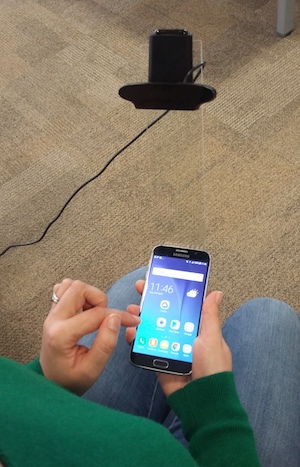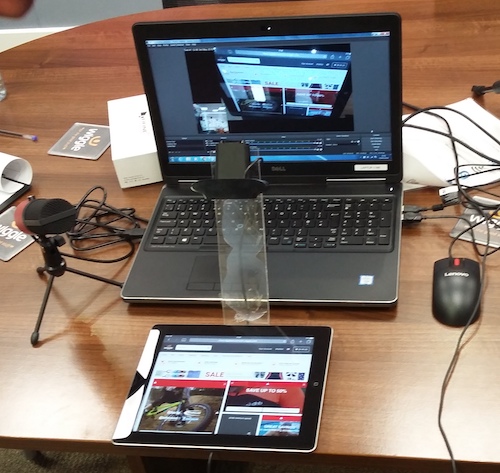Creating a Mobile Usability Lab
Since I have been working at Wiggle there has been a desire to do more live testing with our customers. As a team we have already been out to some of the Wiggle cycle sportive events where we spoke to our customers as they queued for coffee before setting out, but this limits what we can test.
Last year we rented a usability lab in London and did a day of usability tests on our App. This went really well and increased the desire to do more testing with our customers.
With another project getting to a point where we had something to test I started to think about how we could do this in our offices. We would need to test on desktop, mobile and tablet, record the session and stream it for our colleagues to watch and we had a VERY limited budget.
Most of that is pretty standard, but recording what someone is doing on a mobile device is a bit tricky. What I wanted was a sled which could hold a mobile phone with a camera attached, which would be able to see their screen and their hand so you could see what someone is interacting with.
You can buy such a thing, but it is pretty expensive so most UX researchers I have come across either get the participant to use the mobile on a table with a camera leaning over (which is not really how people use them) or have bodged something together with bits and bobs.

This is where I started, finding a device tripod mount that could hold a phone or tablet and connecting that to a flexible arm which could hold a USB webcam. In theory this works really well but in practice it is really heavy and a user would not be able to hold it for long or use it one handed.
How to make it lighter?
My colleague Emma found an article about this very thing, so using Harry's idea I started looking for a plastic supplier.
Easier said than done. Either the size I wanted was too small so I got charged extra or they could not get it to us quick enough. I ended up going to Wickes and getting a large sheet of acrylic. At least it allowed me to make more than one. (We did look at 3D printers but again it is expensive and there are size constraints.)
Now I had my plastic I had to decide what to do with it. I decided to keep to a very basic design, so cut a strip of acrylic 6cm wide, then cut it down to about 30cm long. My husband drilled a hole at the top of the length for me, then helped me bend it lower down with a heat gun. This was less than a 90 degree bend to allow the webcam to see the whole mobile screen.

I was pretty happy with this, but when we tested it the webcam was heavy enough to make it wobble. I cut another piece of plastic and stuck them together which made it better although not perfect.
Next I stuck some velcro to it and we were ready to go.
This sled allows us to test with iPhone, Android and Tablet - the device just needs a little bit of velcro stuck to the back and then it sticks quite happily.
My colleague Emma suggested using OBS studio to record our sessions. This is free software that allowed us to use the webcam on the laptop to record the participants face while also recording what they were doing either on the screen or via the other webcam on a device.
She then helped me to set it up so that we had three unique views, so it was really easy to switch between testing desktop, mobile and tablet if we needed to.
Next we had to work out how to share the tests with the project team, seeing as we do not have a handy room with a mirrored wall to test in. Skype for Business helped us here and again was free as the business already uses it. I booked a meeting room so people could sit together to watch, but for those in other locations or who could not make it they could still join the Skype call and watch too.

We did a couple of tests which worked well, and set everything else up in the normal manner, inviting people from the surrounding businesses to join us for a 15 minute session at lunch time in exchange for a £10 Wiggle voucher.
In the end we managed to test with 19 people and it all went really well. The tests went really smoothly and gave us valuable feedback to take the project forward.
Of course we tweaked the test set up as we went and I have some ideas on how to improve the sled, but for a first go I think it went really well.
The total cost of the lab was just over £50, although that was partly because we borrowed Emma’s webcam. Now we know it works we will buy a team one.
Following the success of this testing I fully expect to be allowed to run more sessions for other projects, which is a amazing step foward for a business who did not even have a UX team two years ago.
